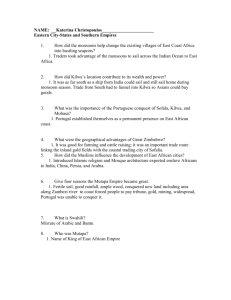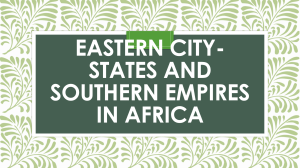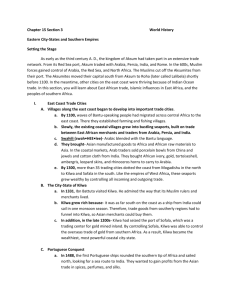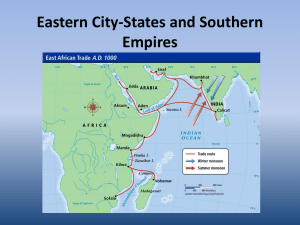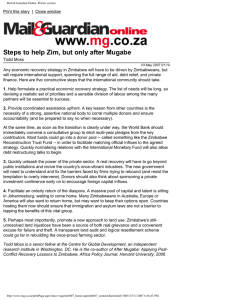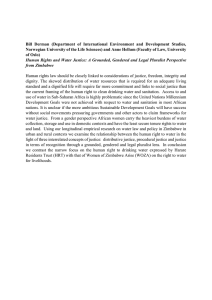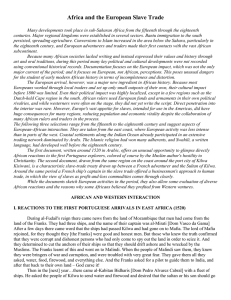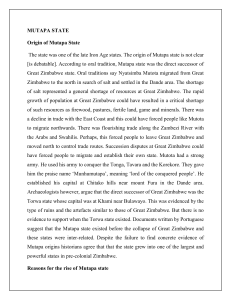Chapter 15.3: Eastern City-States and Southern Empires As early as the 3
advertisement
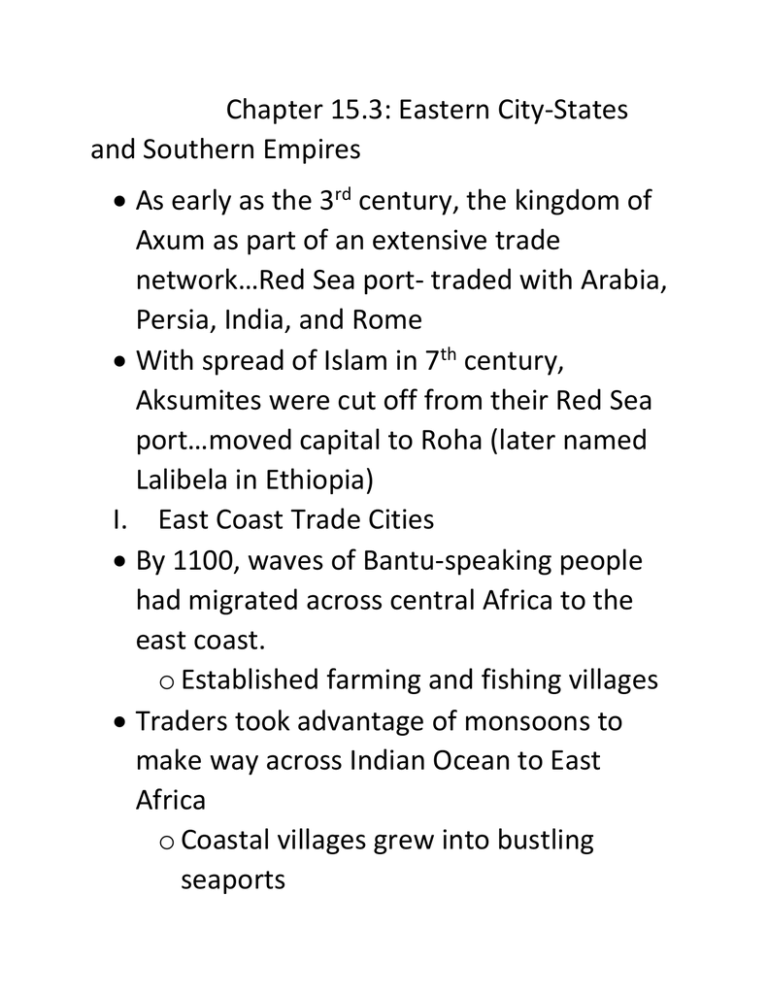
Chapter 15.3: Eastern City-States and Southern Empires As early as the 3rd century, the kingdom of Axum as part of an extensive trade network…Red Sea port- traded with Arabia, Persia, India, and Rome With spread of Islam in 7th century, Aksumites were cut off from their Red Sea port…moved capital to Roha (later named Lalibela in Ethiopia) I. East Coast Trade Cities By 1100, waves of Bantu-speaking people had migrated across central Africa to the east coast. o Established farming and fishing villages Traders took advantage of monsoons to make way across Indian Ocean to East Africa o Coastal villages grew into bustling seaports o Trade between East Africa and Arabia, Persia, and India Swahili Language- blend of Bantu and Arabic o “Swahili” from Arabic meaning “people of the coast” Persian traders- brought Asian manufactured goods to Africa and African raw materials to Asia Arab traders- in coastal markets sold porcelain bowls from China and jewels and cotton cloth from India…bought African ivory, gold, tortoiseshell, ambergris, leopard skins and rhinoceros horns to carry to Arabia… By 1300, more than 35 trading cities dotted the coast from Mogadishu in the north to Kilwa and Sofala in the south o Grew wealthy by controlling all incoming and outgoing trade A. The City-State of Kilwa 1331- Ibn Battua visited Kilwa o Commented on rich material culture Kilwa was as far south on the coast as a ship from India could sail in one monsoon season…trade goods from southerly regions had to funnel into Kilwa, so Asian merchants could buy them Kilwa also seized the port of Sofala…control of overseas gold trade…made Kilwa the wealthiest, most powerful coastal city-state B. Portuguese Conquest 1488, the first Portuguese ships rounded the southern tip of Africa and sailed north, looking for a sea route to India o Portuguese saw the wealth of the Swahili coast and wanted to conquer it for themselves o Using heavy ships’ guns…Portuguese took Sofala, Kilwa, and Mombasa Burned parts of Kilwa and built forts on the sites of Kilwa and Mombasa Portuguese in East Africa for next 200 years II. Islamic Influences Muslim traders introduced Islam to the East African coast o Growth of commerce caused Islam to spread Every town had a mosque Muslim sultan governed most cities Most government officials and wealthy merchants were Muslims A. Islamic Law 1331- Ibn Battuta visited Mogadishu “Questions of religious law are decided by the Qadi, other cases are judged by the …wazirs and amirs. If a case requires the views of the (Shaikh), it is put in writing for him. He sends back an immediate reply” While most rulers, government officials, and merchants were Muslim…the masses still tended to hold traditional beliefs B. Enslavement of Africans Arab Muslims exported luxury goods and enslaved persons from East African coast Africans were acquired through kidnapping and raids and sent to slave markets in Arabia, Persia, and Iraq o Enslaved Africans were also used as soldiers in India o And worked on docks and ships at Muslim-controlled ports o And as household servants in China East African slave trade began around 900CE…greatly increased in volume in the 1700’s III. Southern Africa and Great Zimbabwe Gold and Ivory that was exported from coastal city-states, came from interior of southern Africa Southeastern Africa, Shona people are believed to have established a city called Great Zimbabwe…grew into an empire built on the gold trade A. Great Zimbabwe 1000, Shona people settled on plateau between the Zambezi and Limpopo rivers in modern Zimbabwe o Farming and cattle-raising Located on trade route between inland goldfields and coastal trading city of Sofala 1200’s to 1400’s- Great Zimbabwe became the capital of a thriving state…taxed traders, and demanded tribute City of Great Zimbabwe was the economic, political, and religious center of its empire By 1450, Great Zimbabwe was abandoned, not sure why? o Overgrazing of cattle? o Over-farming? o Resources like salt and timber exhausted? B. Ruins of Great Zimbabwe 60 acres of ruins Portuguese knew about Great Zimbabwe in the 1500’s Karl Mauch, German explorer, one of first Europeans to physically “rediscover” the remains in 1871 o Shallow theory of “cedar” wood…believed left by a lost white tribe from Queen of Sheba Zimbabwe, from Shona phrase meaning, “stone enclosure.” The Great Enclosure o Large soapstone birds o Build without mortar C. Mutapa Empire Shona oral tradition, Mutota left Great Zimbabwe about 1420 to find a new source of salt Eventually, Mutota forced northern Shona people to pay tribute to him Conquered peoples called him mwene mutapa (conqueror or “master pillager”) Became origin of the Mutapa Empire Mutota was succeeded by his son, Matope Mutapa Empire mined gold deposited in nearby rivers and streams o Rulers also forced people in conquered areas to mine gold for them o Rulers sent gold to coastal city-states in exchange for luxuries 1500’s- Portuguese tried to conquer the empire…failed at first, then resorted to interfering in Mutapa politics…foreshadowed European intervention in Africa in the future. Notes: Video Clips- Great Zimbabwe Great Zimbabwe: Karl Mauch Gertrude Caton-Thompson
